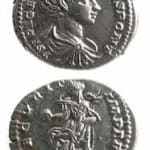Silver Denarius of Geta Struck While Caesar, 199 CE - 202 CE
Silver
C.5700
Further images
Obverse: P SEPT GETA CAES PONT; Draped Bust of Geta Facing Right Reverse: SECVRIT IMPERII; Securitas Seated to the Left, Holding a Glob Publius Septimius Geta was Roman emperor from...
Obverse: P SEPT GETA CAES PONT; Draped Bust of Geta Facing Right
Reverse: SECVRIT IMPERII; Securitas Seated to the Left, Holding a Glob
Publius Septimius Geta was Roman emperor from 209 to 212, jointly with his father, Septimius Severus (reigned 193-211), and his brother, Caracalla (reigned 198-217). The younger son of Septimius Severus and Julia Domna, he was given the title “Caesar” in 198, when the title “Augustus” was bestowed upon his elder brother Caracalla, effectively sharing command with their father. In 209, Geta was himself made an Augustus, joining the ranks of his father and brother. The furious rivalry that developed between the brothers remained concealed from public view as long as their father lived; but after Severus' death at Eboracum (modern York, England) in February 211, the brothers formed separate military factions. Civil war threatened until February 212, when Caracalla had Geta murdered in their mother's arms in her apartment at the imperial palace.
How many hands have touched a coin in your pocket or purse? What eras and lands have the coin traversed on its journey into our possession? As we reach into our pockets to pull out some change, we rarely hesitate to think of who might have touched the coin before us, or where the coin will venture to after it leaves our hands. More than money, coins are a symbol of the state that struck them, of a specific time and location, whether contemporary currencies or artifacts of a long forgotten empire. This stunning hand-struck coin reveals an expertise of craftsmanship and intricate sculptural detail that is often lacking in contemporary machine-made currencies. This ancient coin is a memorial to an emperor’s brief reign passed from the hands of civilization to civilization, from generation to generation that still appears as vibrant today as the day it was struck.
Reverse: SECVRIT IMPERII; Securitas Seated to the Left, Holding a Glob
Publius Septimius Geta was Roman emperor from 209 to 212, jointly with his father, Septimius Severus (reigned 193-211), and his brother, Caracalla (reigned 198-217). The younger son of Septimius Severus and Julia Domna, he was given the title “Caesar” in 198, when the title “Augustus” was bestowed upon his elder brother Caracalla, effectively sharing command with their father. In 209, Geta was himself made an Augustus, joining the ranks of his father and brother. The furious rivalry that developed between the brothers remained concealed from public view as long as their father lived; but after Severus' death at Eboracum (modern York, England) in February 211, the brothers formed separate military factions. Civil war threatened until February 212, when Caracalla had Geta murdered in their mother's arms in her apartment at the imperial palace.
How many hands have touched a coin in your pocket or purse? What eras and lands have the coin traversed on its journey into our possession? As we reach into our pockets to pull out some change, we rarely hesitate to think of who might have touched the coin before us, or where the coin will venture to after it leaves our hands. More than money, coins are a symbol of the state that struck them, of a specific time and location, whether contemporary currencies or artifacts of a long forgotten empire. This stunning hand-struck coin reveals an expertise of craftsmanship and intricate sculptural detail that is often lacking in contemporary machine-made currencies. This ancient coin is a memorial to an emperor’s brief reign passed from the hands of civilization to civilization, from generation to generation that still appears as vibrant today as the day it was struck.





